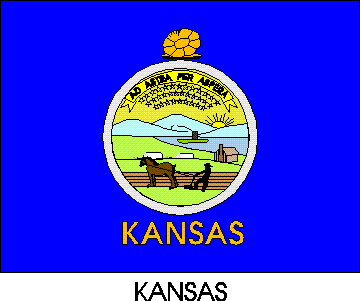
US 50 -- Kansas
Copyright 2012 W. Berg Press
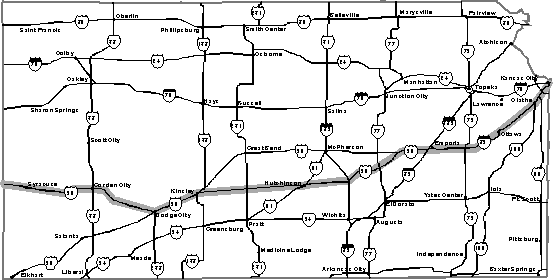
Welcome to Kansas - The Sunflower State.
The capital is Topeka. - State motto is To the Stars Through Difficulties.
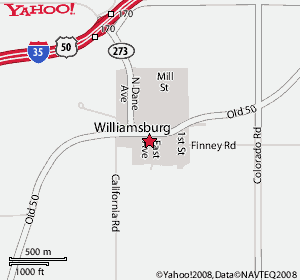
Guy
& Mae's Tavern
The distance from Kansas City to New York City is 1,106 miles. When we
reach the western border of Kansas, it will be an equal distance to San Francisco. So,
once we reach Kinsley, we can say that we have reached the half-way point between New York
and San Francisco.
The US Army Corps of Engineers created Melvern Lake. to control
floods and develop water resources. It is a pretty large lake and just a short distance
north on US 75. A superior campground with private bath and shower facilities, washers and
dryers for laundry is available. Each site is spaced wide apart to maintain privacy. The
weather is warm, so our decision does not take very long. We will stay overnight. The
point where US 50 (I-35 today) and US 75 cross, is called BETO Junction. As the story
goes, 'In the mid 1800's BETO Junction was created to depict the intersection of four
cities. (As it still is today) B - Burlington, E - Emporia, T - Topeka, and O - Ottawa.
Thus the name BETO Junction. It's been estimated that BETO Junction might have had as many
as four different locations in the past 100 years.
Emporia is the home of the National Teachers Hall
of Fame. A brochure reminds us how one-room schoolhouses with their large wooden
tables and chalkboards have evolved to state-of-the-art classrooms with satellite dishes
and individual computers. Teachers have adapted to meet changing student needs and
societal trends. Students now have options to pursue studies such as an online
MBA that could lead to become masters
in communication, if they so choose.
Ms. Ida Daniel Dark-National Teachers Hall of Fame 1993 Inductee from
Philadelphia, Pennsylvania-stated: 'The charge to mold the minds of children toward an
intellectual, social, and ethical maturity is one of the greatest responsibilities a human
being can undertake.'
As we drive through Chase
County, the Bluestem Pasture region of Kansas, we are reminded that this vast prairie
is more commonly known as the Flint Hills. Named for its predominant grasses, the area
extends from Oklahoma almost to Nebraska. The region is narrow, oval, and only two
counties wide. It covers some 4 1/2 million acres. These pastures comprise the last large
segment of true prairie which once stretched from the forests of the East to the Great
Plains. Today, these nutritious grazing lands fatten almost one million head of cattle
each year.
NEWTON has a famous past from the
'Old West.' From 1871 to 1874, the city became known as 'bloody and lawless-the wickedest
city in the West.' In 1872 the western end of the Atchinson, Topeka and Santa Fe Railway
came to town. With it hordes of gun slingers, gamblers, 'soiled doves,' cowboys and
railroad crews arrived to make this town more dangerous than Abilene and Dodge City. As
the railroad moved farther west, things became more orderly. Soon Mennonites from Russia
arrived. Among the immigrants was Bernhard Warkentin who pioneered 'Red Turkey' hard
winter wheat. The Kansas prairie soil was similar to the steppes in their Russian
homeland. The Mennonites' hard work brought success and created what is today known as the
"bread basket of the world."
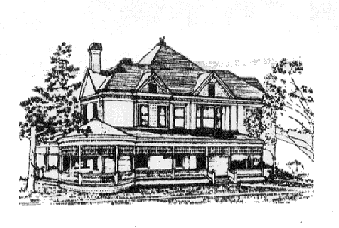
The Warkentin House at 211 East First Street is an elegant, 16 room Victorian home was
built and completed in 1887 by Bernhard and Wilhelmina Warkentin. Warkentin played a
dominant role in planting a hardy, high-yield variety of wheat that gave Kansas its
enormous productivity and brought him fame and fortune.
Hutchison which is the wheat capital of the world. As we approach the city, we see huge
grain elevators along the railroad tracks. The railroad, as it does in all western towns,
runs right through the middle of Hutchison. We hear the whistles blowing as the trains
cross each street on their way through the town. There is no doubt in our minds that we
are now in the West. Lifestyle, architecture and way of life have changed from the East.
Terminal Elevator "J." is the third largest in the world and can store
approximately 18 million bushels of grain. One million bushels of grain is equal to 300
railroad cars or 1,000 trucks. Multiply by 18 and that's the volume of grain which is
stored here. The facility can load or unload 11 jumbo rail hopper cars per hour. At that
rate, it would take 21 days to load-out the entire elevator and fill 5,500 rail cars. The
total length of the building is 2,573 feet. That is 67 feet short of a half mile. It
required 150,000 cubic yards of concrete for construction, which represents a line of
cement trucks from Hutchinson to Dodge City -- 124 miles or almost 200 kilometers.
The world's largest salt deposit is in Hutchinson. This deposit is 100 miles by 40 miles,
325 feet thick, and yields 44.1 million tons of salt each year. Old salt mines, that are
650 feet under ground, have been converted to security storage. Nature maintains a
constant temperature of 68 degrees with virtually no humidity. This environment is ideally
suited for record storage.
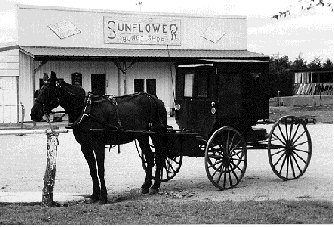
Yoder is a small farming village where Mennonites and other cultures coexist. Sam Yoder is
a carriage maker and one of the original descendants of the Yoder clan. He is the owner of
the Sunflower Buggy Shop, likes to talks about the Amish lifestyle and today's need for
buggies which he constructs and repairs. We have an interesting conversation on the
philosophy of life. He believes and practices love and pursuit of wisdom by means and
self-discipline. So, if you stop by, tell him that Wulf and Heide Berg, the people who
traveled US 50, mentioned his buggy shop and that you wanted to see it for yourself. He'll
give you a good talk as long as you want to listen.
Just a few miles west of Hutchinson,
we
take a side step into Stafford, a town along the railroad track.
Staffordís streets are laid of brickóred brick.
I havenít seen too many cities that have brick laid streets.
US 50 used to go through the center of town, but today it bypasses around
the town. So, if you want to see the
city, enter on Main Street, and then take a left on Broadway, which is the old
US 50. We are amazed how wide the
street is, because it used to accommodate the cross-country traffic.
You may want to stay in this
very charming community.
Check out the Henderson House Inn &
Retreat Center and mention Route50.com
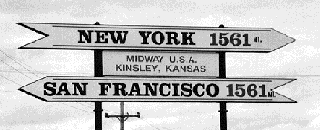
Kinsley, Kansas, is the half-way point between the two coasts. We find a sign at the
intersection of US 50 and 56 where it proclaims to be midway between New York and San
Francisco. In either direction it is 1,561 miles.
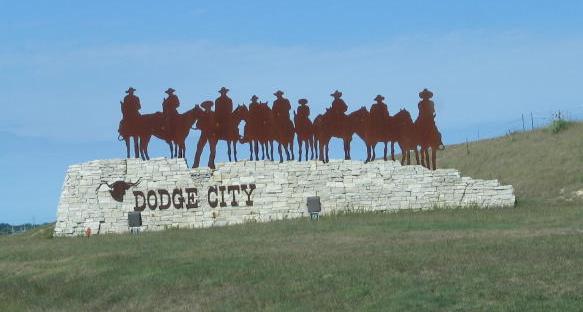
This symbolic picture taken by Richard
Elliott. Dodge City, a frontier town, has been
described and portrayed in many movies. Most famous of them all is the movie and
television series "Gunsmoke." Many movies have made this city famous. Dodge City
proclaims itself as 'The Queen of the Cowtowns.' In early days, cattle trade brought Dodge
City prosperity and violence. During those wild and wooly days, Dodge City was home to
such top lawmen and gunfighters as Wyatt Earp, Luke Short, the Masterson Brothers, Doc
Holliday and Bill Tilghman.
You may want to
explore 'The
Adventures of Travis & Muldoon'. Jack
Underhill takes you away from today to follow the Santa Fe Trail into the
imagined olden days when all that threatened a man were feral Indians and loco
mountain men, fearless wild beasts and the raw, untamed elements of sky and
land.
In Garden City, we find Crazy
House - the Boot King of Kansas. If you want western wear, that's the place to look for
it. And I mean-look for it. It's a huge barn full of western gear, but you have to search
or ask if you cannot find directly what your heart desires. It is a stop where you can get
your western hat and a pair of boots. And don't leave Kansas without them.
We change to mountain time in Kendall and thereby gain an additional hour of daylight for
driving. Folks are very friendly In Syracuse. Our hotel marquee displays the following
philosophy: 'An intellectual is a man who takes more words than necessary to tell more
than he knows'. Take a closer look at the town's murals. There are four. The artists, who
lived here at that time, were commissioned to enhance the town image. All these small
towns are very eager and work hard to improve their image and to reflect on their
heritage.
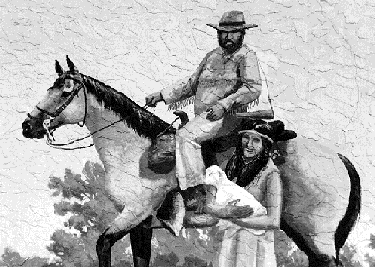
Leaving Kansas! Come again.
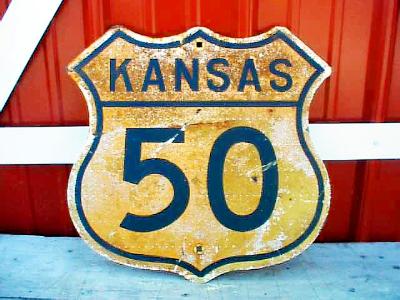

For more information on Kansas visit
Kansas Sights or
Santa Fee
Trail
Thanks to Robert Edgar
in Bakersfield, California
for sending us a photo of the Kansas road sign from his collection.
go back to US50, Coast to Coast

My book "US 50, Coast to Coast" guides you on this journey in greater
details.
To obtain information on ordering a copy of US 50 COAST to COAST,
click here











